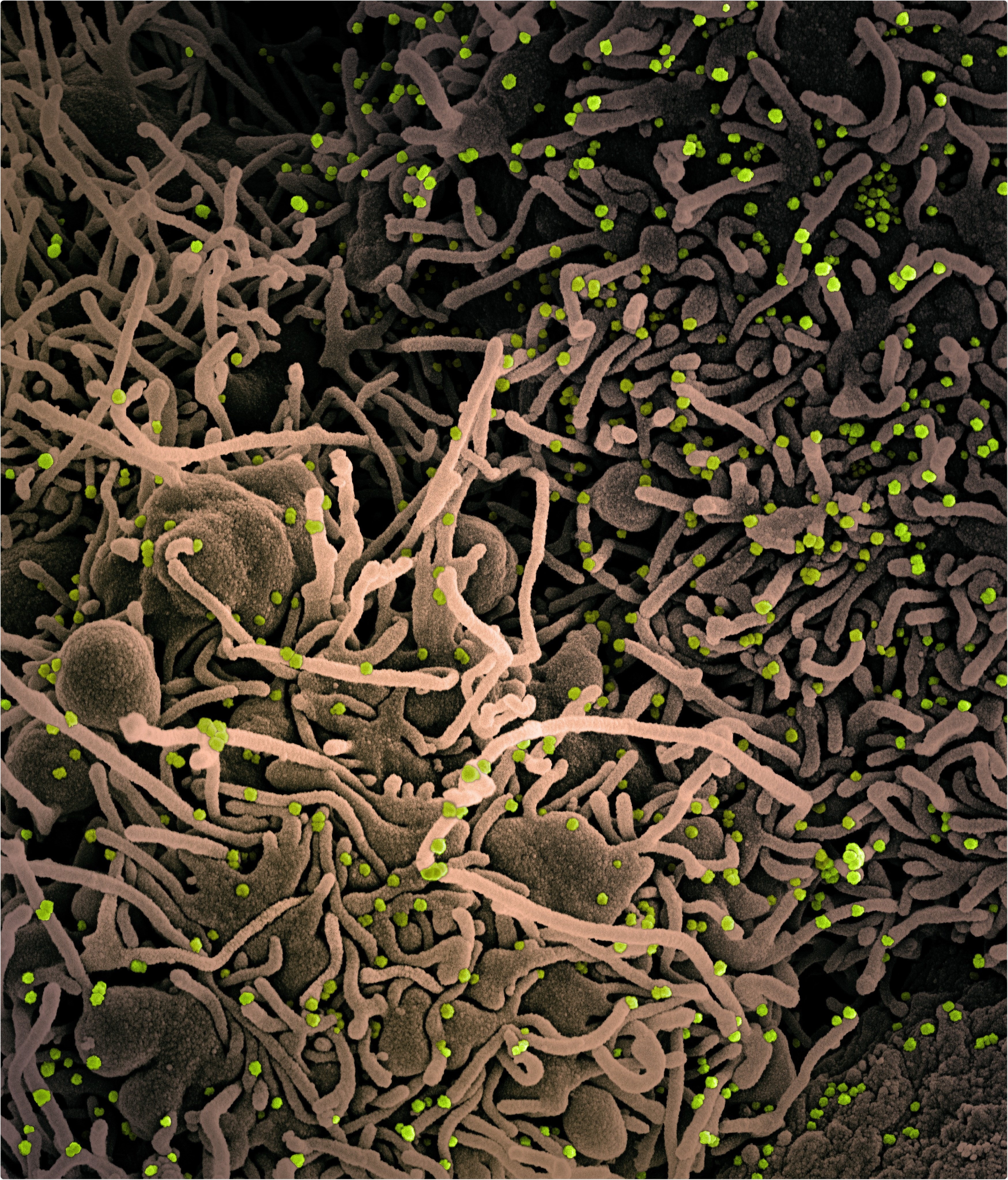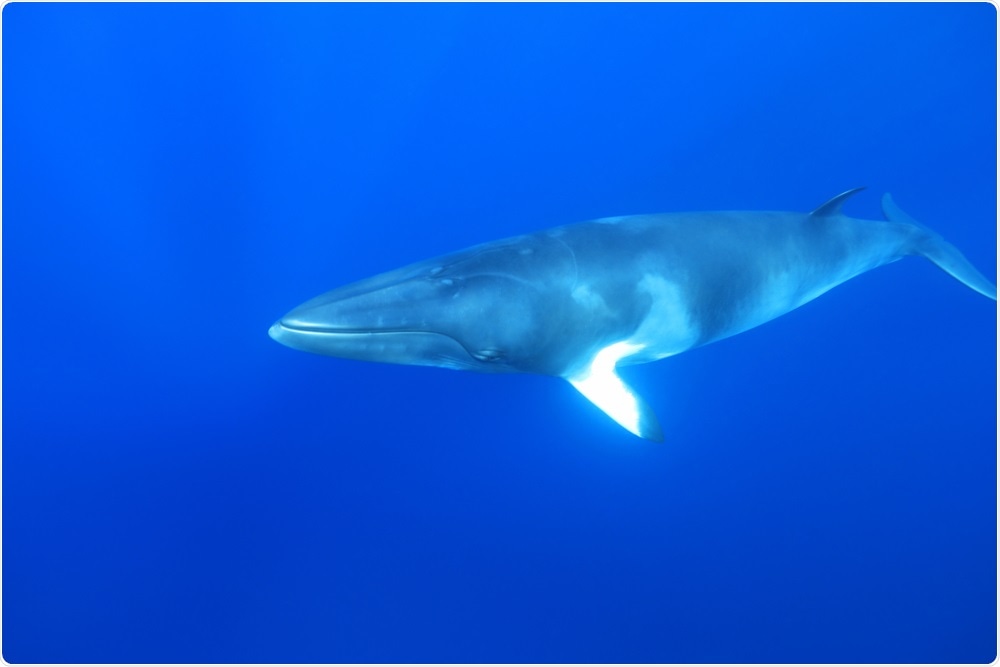With the sudden and extensive spread of COVID-19 all over the world, scientists have been seeking to identify the routes of transmission so as to flatten the curve of the pandemic. A recent report by scientists in the United Kingdom and Poland and published on the preprint server medRxiv* in June 2020 describes the presence of stable severe acute respiratory syndrome coronavirus 2 (SARS-CoV-2) in water for up to 25 days, with the risk of infection by the contaminated water varying by the country’s environment.

NIAIDFollow Novel Coronavirus SARS-CoV-2 Colorized scanning electron micrograph of a VERO E6 cell (tan) exhibiting elongated cell projections and signs of apoptosis, after infection with SARS-COV-2 virus particles (green), which were isolated from a patient sample. Image captured at the NIAID Integrated Research Facility (IRF) in Fort Detrick, Maryland. Credit: NIAID

 This news article was a review of a preliminary scientific report that had not undergone peer-review at the time of publication. Since its initial publication, the scientific report has now been peer reviewed and accepted for publication in a Scientific Journal. Links to the preliminary and peer-reviewed reports are available in the Sources section at the bottom of this article. View Sources
This news article was a review of a preliminary scientific report that had not undergone peer-review at the time of publication. Since its initial publication, the scientific report has now been peer reviewed and accepted for publication in a Scientific Journal. Links to the preliminary and peer-reviewed reports are available in the Sources section at the bottom of this article. View Sources
This could have severe implications for the state of freshwater systems, the seacoast ecology, and the re-emergence of the virus. Today, it is thought that above 40% of infection goes undetected because of the absence of symptoms.
This comes off the back of another recent study by scientists in Ecuador, previously reported by News-Medical, that showed that SARS-CoV-2 to be present in rivers flowing through Quito, implying an enormous transmission risk in developing countries without adequate sanitation facilities.
Waterborne Viral Infections
Waterborne pathogens are substantial health risks, and viruses in this class include adenovirus, astrovirus, hepatitis A, hepatitis E, rotavirus, norovirus, and other enteroviruses. Coronaviruses (CoVs) are known to survive in water, and viral loads in untreated sewage correlate with the population prevalence. Viruses are likely to survive in cold water for more extended periods than in hot. Available evidence suggests that water contaminated with sewage is a potential route of orofecal transmission.
Many possible routes exist for sewage contamination of water used for human cooking and drinking. For instance, the overflow from sewers combined with the leakage of sewage from containing pipes; failure of sewage processing systems; lack of infrastructure in impoverished regions of the world; can all provide ways in which viruses are transmitted to other people by water.
Even during the present pandemic, sewage spills have contaminated houses, shared community spaces, and temporary settlements, which probably lack safe sanitation systems, thus encouraging spread via this route. Another cause of increased viral load in sewage systems is the presence of superspreaders in the population contributing to that sewage, even when the rest of the population has a low prevalence.
The Study: Examining the Viral Load After Sewage Spills
The current study examined in vitro data to first establish the survival capability of the virus, finding that it could remain viable and stable for up to 25 days.
The researchers then used a pollution analysis technique called ‘down the drain’ to find the level of expected dilution of the sewage by the river water. This yielded an estimate of how much risk humans in 39 countries could expect from sewage spills.
The relative risk (RR), which is the normalized country comparable risk, associated with a sewage spill after dilution by river water, varies with the extent of domestic water use, as well as the weather, the locale, and topography of the area. Those areas with high water usage and high dilution, like Canada and Norway, have the lowest RR. The highest RR is in countries like Germany and Spain where domestic water use is low to medium, but dilution is also low.
Based on the proportion of cases, on May 3, 2020, for the population of 21 countries, they estimated the upper and lower concentration limit of the waterborne virus in the first 24 hours of a sewage spill. Based on the ratio of infectious virus to genome copies, they selected a high, medium, and low estimate, at one in ten, one in a hundred, and one in a thousand, respectively. This agrees with the 10-3 value that is used in other studies to evaluate the risk of virus load, as in one study examining the risk of transmission of the SARS-CoV-2 to sanitation workers.
The researchers found that these estimates showed concentrations of waterborne virus in a viable form that posed a high risk of infection in case of fecal contamination. In countries with a higher RR, if the water was colder, and the rate of population infection was high, the absolute concentrations of the viable virus were higher. During winter, the risk will go up, but the age of the sewage and the temperature during the last few days or hours will be required to understand the impact of detected virus loads.
How This Affects Transmission Risk
On the assumption that 100 copies would be necessary for infection, the researchers estimated that an inhabitant of any of the three countries with the highest virus concentrations who drank 100 ml of contaminated water within 24 hours would get about 470 copies, which carries a high probability of infection.
-1.jpg)
Image Credit: Kateryna Kon/Shutterstock.com
To put things in perspective, this is the equivalent of drinking just one or two mouthfuls of water, whereas swimmers often swallow almost three times this much, approximately 280 ml, during a swim of 45 minutes.
Following the first 24 hours after spill, the virus concentration will change depending on the river water concentration. Thus, in hotter climates like Morocco, the concentrations will drop rapidly over this period, to 15% by 48 hours post-spill. Still, in Spain and the UK, the colder temperatures mean a more prolonged period of survival, with about 50% of the virus remaining detectable at this point.
Animals may also be infected by feeding on grass or shrubs growing in contaminated areas downstream of the spill.
How Does This Affect Drinking Water Safety?
The survival capacity and transportability of the virus in rivers could affect the supply of drinking water in countries which depend primarily on rivers or river reservoirs for potable water, or in communities living with low sanitation facilities near the water source, implying a high possibility of source contamination with sewage.
Filtering and chlorination or ultraviolet disinfection are the best ways to ensure safe drinking water. However, the dose of chlorine or ultraviolet irradiation applied may vary from one region or country to another, and may not meet the minimum limits required for reducing SARS-CoV-2 loads to undetectable levels.
The researchers recommend, “Reviewing of regional or countrywide drinking water processing approaches is recommended to reduce the potential for SARS-CoV-2 surviving through drinking water processing systems. The boiling of drinking water will result in the virus being deactivated. Refrigerated food that becomes contaminated (e.g., through washing or handling) could remain infectious for up to 25 days.”
What Does This Mean for Marine Life?
The stability of the virus at different pH and salt concentrations in cold water could mean that the SARS-CoV-2 virus can survive in both fresh and seawater without much difference. In fact, the virus has been found in seawater exposed to untreated sewage and may build up within scavengers like mollusks, which are known for their biomagnification capabilities.
Cetaceans, especially whales, are known to express ACE2 receptors with high similarity levels to humans, which means they can be vulnerable to the infection. Whales have large throats, swallow large amounts of water as they filter-feed, and eat along the coastline on sea animals that are found at sites where sewage enters the ocean. For instance, minke whales feed on mackerel and orca whales on chinook salmon.

Dwarf minke whale (Balaenoptera acutorostrata). Image Credit: aquapix / Shutterstock
This could expose them to large doses of the virus – it is estimated that a medium-sized whale could receive 5.65 million copies of the virus every second, and this could, in turn, reflect in increased exposure of humans to the virus through seafood – a circular path of transmission.
The study concludes, “The analysis suggests that public interactions with rivers and coastal waters following wastewater spills should be minimized to reduce the risk of infection.” The main risk is human-to-human spread, but it could also allow the virus to infect new animal species and, in turn, result in a future re-entry of the virus into the human population.

 This news article was a review of a preliminary scientific report that had not undergone peer-review at the time of publication. Since its initial publication, the scientific report has now been peer reviewed and accepted for publication in a Scientific Journal. Links to the preliminary and peer-reviewed reports are available in the Sources section at the bottom of this article. View Sources
This news article was a review of a preliminary scientific report that had not undergone peer-review at the time of publication. Since its initial publication, the scientific report has now been peer reviewed and accepted for publication in a Scientific Journal. Links to the preliminary and peer-reviewed reports are available in the Sources section at the bottom of this article. View Sources
Article Revisions
- Mar 22 2023 - The preprint preliminary research paper that this article was based upon was accepted for publication in a peer-reviewed Scientific Journal. This article was edited accordingly to include a link to the final peer-reviewed paper, now shown in the sources section.